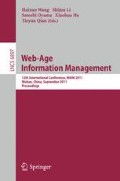Abstract
The utilization of shared LLC(Last Level Cache) is important for efficiency of multi-core processor. Uncontrolled sharing leads to cache pollution i.e. the weak locality data(single-usage data without re-using) continuously evict the strong locality data (frequently re-used data) from LLC in both inner query processing and co-running programs. For analytical MMDB (Main-Memory Database) applications, with skewed star schema of DW, more than 95% memory capacity is occupied by memory-resident fact table with weak locality and there are only small size dimension tables with strong locality. Cache partitioning must manage data with different localities inside query processing to avoid cache pollution by weak locality fact table. The static OS-based cache partitioning suffers from insufficient memory address capacity due to large fact table and the dynamic OS-based cache partitioning also suffers from data movement overhead during cache re-allocation. In order to employ a practical and effective cache partitioning policy, we propose an application software-based W-order scan policy for real analytical MMDB application. The consecutive physical address based W-order policy is proposed to reduce cache misses with high memory utilization by controlling the physical page accessing order within large and consecutive physical pages. Another approach is page-color index i.e. we extract page-color bits from pages of weak locality data and sort the page address by page-color bits, when we perform a page-color index scan, we can control the physical page accessing order too without supporting from OS for large consecutive physical page allocating. We measure the L2 cache miss rate by simulating a typical hash join operation. The experimental results show that DBMSs can improve cache performance through controlling weak locality data accessing pattern by themselves oppose to depending on supports by hardware or OS.
Access this chapter
Tax calculation will be finalised at checkout
Purchases are for personal use only
Preview
Unable to display preview. Download preview PDF.
References
Taylor, G., Davies, P., Farmwald, M.: The TLB slice-a low-cost high-speed address translation mechanism. In: Proceedings of the ISCA 1990, pp. 355–363 (1990)
Lin, J., Lu, Q., Ding, X., Zhang, Z., Zhang, X., Sadayappan, P.: Gaining insights into multi-core cache partitioning: Bridging the gap between simulation and real systems. In: Proceedings of the14th International Symposium on High-Performance Computer Architecture, pp. 367–378 (2008)
Piquet, T., Rochecouste, O., Seznec, A.: Minimizing Single-Usage Cache Pollution for Effective Cache Hierarchy Management. Research report (2006), http://hal.inria.fr/docs/00/11/66/11/PDF/PI-1826.pdf
Piquet, T., Rochecouste, O., Seznec, A.: Exploiting Single-Usage for Effective Memory Management. In: Proceedings of Asia-Pacific Computer Systems Architecture Conference, pp. 90–101 (2007)
Chang, J., Sohi, G.S.: Cooperative cache partitioning for chip multiprocessors. In: Proceedings of the 21st Annual International Conference on Supercomputing, pp. 242–252 (2007)
Kim, S., Chandra, D., Solihin, Y.: Fair cache sharing and partitioning in a chip multiprocessor architecture. In: Proceedings of the 13th International Conference on Parallel Architectures and Compilation Techniques, pp. 111–122 (2004)
Qureshi, M.K., Patt, Y.N.: Utility-based cache partitioning: A low-overhead, high-performance, runtime mechanism to partition shared caches. In: Proceedings of the 39th International Symposium on Microarchitecture, pp. 423–432 (2006)
Suh, G.E., Rudolph, L., Devadas, S.: Dynamic partitioning of shared cache memory. The Journal of Supercomputing 28(1), 7–26 (2004)
Chandra, D., Guo, F., Kim, S., Solihin, Y.: Predicting inter-thread cache contention on a chip multi-processor architecture. In: Proceedings of HPCA (2005)
Guo, F., Solihin, Y.: An analytical model for cache replacement policy performance. In: Proceedings of SIGMETRICS (2006)
Bray, B.K., Lynch, W.L., Flynn, M.: Page allocation to reduce access time of physical caches. Tech. Rep. CSL-TR-90-454, Computer Systems Laboratory, Stanford University (1990)
Taylor, G., Davies, P., Farmwald, M.: The TLB slice – A low-cost high-speed address translation mechanism. In: Proceedings of the 17th Annual International Symposium on Computer Architecture, pp. 355–363 (1990)
Kessler, R.E., Hill, M.D.: Page placement algorithms for large real-indexed caches. ACM Transactions on Computer Systems 10(11), 338–359 (1992)
Sherwood, T., Calder, B., Emer, J.: Reducing cache misses using hardware and software page placement. In: Proceedings of the 13th International Conference on Supercomputing, pp. 155–164 (1999)
Tam, D., Azimi, R., Soares, L., Stumm, M.: Managing shared L2 caches on multicore systems in software. In: Proceedings of WIOSCA 2007 (2007)
Lee, R., Ding, X., Chen, F., Lu, Q., Zhang, X.: MCC-DB: Minimizing Cache Conflicts in Multi-core Processors for Databases. PVLDB 2(1), 373–384 (2009)
Zhang, X., Dwarkadas, S., Shen, K.: Towards practical page coloring-based multicore cache management. In: EuroSys 2009, pp. 89–102 (2009)
Lu, Q., Lin, J., Ding, X., Zhang, Z., Zhang, X., Sadayappan, P.: Soft-OLP: Improving Hardware Cache Performance through Software-Controlled Object-Level Partitioning. In: Proceedings of PACT 2009, pp. 246–257 (2009)
Lin, J., Lu, Q., Ding, X., Zhang, Z., Zhang, X., Sadayappan, P.: Enabling software management for multicore caches with a lightweight hardware support. In: Proceedings of SC 2009 (2009)
Boncz, P.A., Mangegold, S., Kersten, M.L.: Database architecture optimized for the new bottleneck: Memory access. In: Proceedings of the VLDB 1999, pp. 266–277 (1999)
Author information
Authors and Affiliations
Editor information
Editors and Affiliations
Rights and permissions
Copyright information
© 2011 Springer-Verlag Berlin Heidelberg
About this paper
Cite this paper
Zhang, Y., Jiao, M., Wang, Z., Wang, S., Zhou, X. (2011). W-Order Scan: Minimizing Cache Pollution by Application Software Level Cache Management for MMDB. In: Wang, H., Li, S., Oyama, S., Hu, X., Qian, T. (eds) Web-Age Information Management. WAIM 2011. Lecture Notes in Computer Science, vol 6897. Springer, Berlin, Heidelberg. https://doi.org/10.1007/978-3-642-23535-1_41
Download citation
DOI: https://doi.org/10.1007/978-3-642-23535-1_41
Publisher Name: Springer, Berlin, Heidelberg
Print ISBN: 978-3-642-23534-4
Online ISBN: 978-3-642-23535-1
eBook Packages: Computer ScienceComputer Science (R0)

